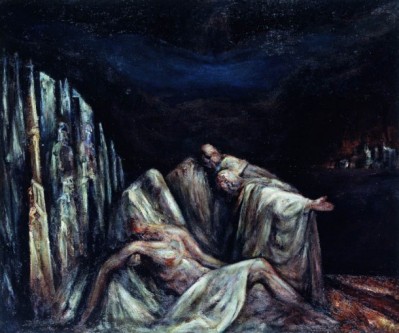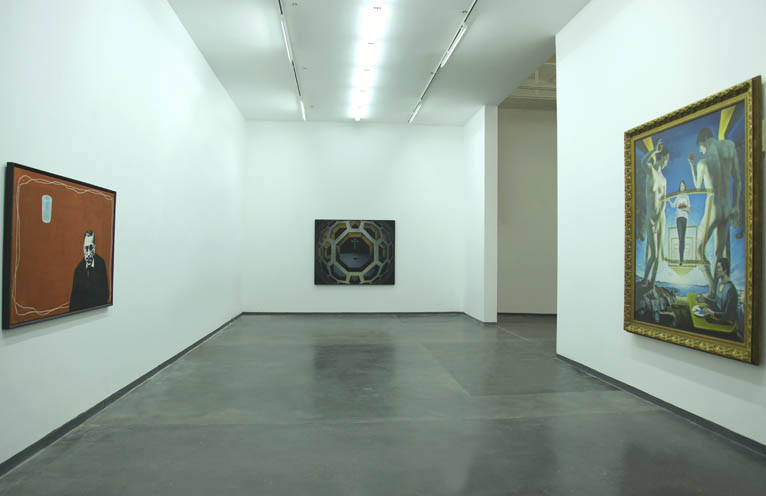THIRTY YEARS OF CHINESE CONTEMPORARY ART: PAINTING 1979-2009
| June 1, 2010 | Post In LEAP 3

If Minsheng Art Museum’s opening exhibition, a thirty-year survey of painting in China, can be seen in relation to any recent show, it is the National Art Museum of China’s “Report to the Motherland: 60 Years of Art in the New China,” curated by Fan Di’an in the lead-up to the PRC’s 60th anniversary celebrations last September. In that show, Fan and NAMOC collapsed the distinction between the supposed new trends of the Reform Era and everything that had come before, reminding the national public that in the official consciousness at least, the period known as “contemporary” (dangdai) actually began in 1949.
The opening room of this exhibition follows that lead, offering an entirely figurative survey of the very early 1980s, one that stresses not rupture with the art of the PRC’s first thirty years, but transformation based upon it. Cheng Conglin, for example, is represented not by a Scars painting of Cultural Revolution chaos, but an orthodox depiction of poor Sichuanese on a river wharf before Liberation. Zhou Chunya shows an ethnic impasto of smiling Tibetans; Ai Xuan a portrait of a girl on crutches in a library, glancing down at an English dictionary. The Sichuanese currents ebb and flow, with an early Zhang Xiaogang of curvaceous mountains and clouds framing a breastfeeding mother and an onlooking lamb, and a Luo Zhongli in which a sandaled peasant screams at the stormy sky. But works like these are juxtaposed with the quintessentially academic, nudes and portraits like Yang Feiyun’s Nineteen Years Old or Jin Shangyi’s Young Singer, which show mostly that in this moment, Western classicism was again palatable. Altogether, this is the antediluvian contemporary Chinese art, most of it from the inland. And it’s a strong position to suggest that it, and not the avant-garde movements of the coastal cities, is where we should locate the beginning of what we are also asked to believe is a coherent movement.
The conceptual boom hits in the next gallery, with the knockout pairing of Zhong Ming’s 1980 Sartre—He is Himself across from Meng Luding and Zhang Qun’s In the New Era: Apocalypto of Adam and Eve. By room 2.5 we are well into the standard story of the ’85 New Wave, one familiar to viewers of the UCCA’s opening show back in 2007, even if things here never get so radical as Huang Yong Ping’s paint-by-roulette subversions. Still there are some curious asides, pieces like Ding Fang’s To the Faith—Sabbath, an abstracted pieta in misunderstood terms, equal parts Caravaggio, Bacon and El Greco. As abstracted deconstructions of stock Christian scenes go, it makes for an interesting counterpoint to Wang Guangyi’s early work. Elsewhere in this room, the stalwart duo of Zhang Peili’s gloves and Geng Jianyi’s barbershop hangs squarely on a serious wall, across from a framed poster for the 1989 China/Avant-Garde exhibition.

A subsequent gallery throws the viewer into the very early 1990s, and particularly the New Students Generation. This is not the tame, realist-technique-to-unmonumental-ends version of this loose movement; instead, we see a visceral 1995 self-portrait by Yu Hong, perched nude in a tree. Zhao Bandi’s 1989 Girl Peeling an Apple suggests the place he might have assumed in a largely painting-based pecking order, had he not veered off toward pandas during the second half of the 1990s. (For the record, the girl at the center of this composition wears a black-and-white striped sweater, in a sinister hint of things to come). An intervening room of ink works mostly provides a stage for Wenda Gu’s multi-sheet Drama of Two Cultures Merging, a mutated-character work of great pathos. Most remarkably, in a corner hangs Qiu Zhijie’s thousand-time rewriting of the Lotus Pavilion Preface, in its original, crackling state.
The show’s narrative is full of ingenious twists, turning through a room of Ding Yi, Li Shan and Yu Youhan before entering the auctioneer’s dream chamber of Political Pop and Cynical Realism. Here, in 360 degrees, we see major works by Fang Lijun, Zeng Fanzhi, Qi Zhilong, Wang Guangyi, Zhang Xiaogang, Liu Wei and Yue Minjun. It’s the sort of hanging that evokes precisely the security of a bank, which Minsheng of course is. And then, through yet another door, a room of realism—Leng Jun, Shi Chong, Mao Yan, Chao Ge—provides a counterpoint to the made-for-foreigners suspicions that the market leaders can seemingly never shake.
As the show hurdles toward the present, its narrative of innovation struggles to maintain coherence. The 2000s room is a funny creature, full of equivalences not naturally occurring but somehow still convincing. Chen Wenbo is paired with Yan Lei, Wang Yin with Yang Shaobin and Wang Xingwei with Yin Chaoyang. In each case, an artist who is presumed to enjoy better standing on the level of “taste” finds himself in dialogue with a contemporary who has received more attention on the market. The pairings, paradoxically, work in everyone’s favor, serving to break down the false binaries of the bubble years, which too easily pitted crude ideas of the purely conceptual against the market creation.

Upstairs, things devolve quickly in two rooms devoted to the art of the last five years. The show cannot be entirely faulted, for to do simultaneous justice to the giants of the 1980s and the twinkling supernovas of the late 2000s is beyond the pale of any museum, let alone a brand new one. And yet I find it hard to accept that the glorious arc of painterly experiment should end with figures like Wei Jia, Xiong Yu and Ouyang Chun. Hasty decisions seem to have been the order of the day, with one print by Ye Nan plucked off the walls of a show that closed at a gallery in Beijing just weeks before. Even artists who generally come off well in such settings—Jia Aili, Sun Xun, MadeIn—are here reduced to the lowest common denominator of “Post-80s” taste. Hopefully this is more a reflection of curatorial overreach than a true indication of the worsening state of the field.
An inspired walk through a long and complex narrative, the exhibition ultimately leaves the viewer to ask what sort of history can be written of these three decades. If the original Stars-inspired, China/Avant-Garde-reinforced conceit of artists as freedom fighters and stylistic pioneers has faded, the Gao Minglu model which posits Western Modernism as the new Buddhism—i.e. subject to a lengthy and thorough process of Sinification—has yet to fully take hold. Stranded between these two understandings, are we able to eke out anything other than an empty montage, like the one that appeared between speeches at the Minsheng Art Museum’s opening banquet, in which the dates of the years between 1979 and 2009 float, dissipate and reconfigure themselves into the giant numbers “30”? In other words, can we do much more than acknowledge that things have changed and time has passed? Philip Tinari

